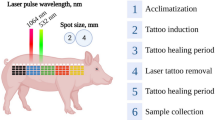Abstract
Now more than ever, there is an increasing demand for effective and efficient laser tattoo removal methods. Different variables can be manipulated in order to improve delivery and outcomes in laser tattoo removal. Originally, alterations in pulse duration, wavelength, lasing medium, and fluence were utilized to enhance laser tattoo removal results. In contrast, research has shifted to improving the delivery of laser light to the tattoo pigments. Development laser light delivery utilizing perfluorodecalin (PFD), optical clearing agents (OCA), R20, and R0 methods have revolutionized the field. As a result, the number of treatments and time per treatment has decreased while still remaining effective. A look into the literature has shown promising but limited results with the aforementioned technologies for laser tattoo removal. Further studies are needed to make definitive statements regarding R20, R0, and OCAs in laser tattoo removal.

Similar content being viewed by others
References
Papers of particular interest, published recently, have been highlighted as: • Of importance •• Of major importance
Laser therapy for unwanted tattoos. ASDS website. [Last accessed on 2015 Aug 16]. Available from https://www.asds.net/_PublicResources.aspx?id=6073
Bergstrom KG. Tattoo removal: new laser options. J Drugs Dermatol. 2013;12(4):492–3.
Herd RM, Alora MB, Smoller B, Arndt KA, Dover JS. A clinical and histologic prospective controlled comparative study of the picosecond titanium:sapphire (795 nm) laser versus the Q-switched alexandrite (752 nm) laser for removing tattoo pigment. J Am Acad Dermatol. 1999;40(4):603–6.
Ross V, Naseef G, Lin G, et al. Comparison of responses of tattoos to picosecond and nanosecond Q-switched neodymium: YAG lasers. Arch Dermatol. 1998;134(2):167–71.
Saedi N, Metelitsa A, Petrell K, Arndt KA, Dover JS. Treatment of tattoos with a picosecond alexandrite laser: a prospective trial. Arch Dermatol. 2012;148(12):1360–3.
Freedman JR, Kaufman J, Metelitsa AI, Green JB. Picosecond lasers: the next generation of short-pulsed lasers. Semin Cutan Med Surg. 2014;33(4):164–8.
Kossida T, Rigopoulos D, Katsambas A, Anderson RR. Optimal tattoo removal in a single laser session based on the method of repeated exposures. J Am Acad Dermatol. 2012;66(2):271–7. One of the first studies to propose and support the use of multi-pass therapy, known as R20 in laser tattoo removal. This study was one of the first to studies to provide a way to circumvent optical scattering due to superficial whitening reaction.
Reddy K, Brauer JA, Anolik R, Bernstein L, Brightman L, Hale E, et al. Topical perfluorodecalin resolves immediate whitening reactions and allows rapid effective multiple pass treatment of tattoos. Lasers Surg Med. 2013;45(2):76–80. The first randomized controlled study utilizing R0 in laser tattoo removal and comparing it to conventional therapy.
Luebberding S, Alexiades-Armenakas M. New tattoo approaches in dermatology. Dermatol Clin. 2014;32(1):91–6.
Biesman BS, O’Neil MP, Costner C. Rapid, high-fluence multi-pass q-switched laser treatment of tattoos with a transparent perfluorodecalin-infused patch: a pilot study. Lasers Surg Med. 2015;47(8):613–8. This proof of concept split tattoo study presents an in-depth evaluation and discussion on PFD use in laser tattoo removal.
Bernstein EF. Commentary: on Biesman et al. rapid, high-fluence multi-pass Q-switched laser treatment of tattoos with a transparent perfluorodecalin-infused patch: a pilot study. Lasers Surg Med. 2015;47(8):619.
Shah SD, Aurangabadkar SJ. Newer trends in laser tattoo removal. J Cutan Aesthet Surg. 2015;8(1):25–9.
Sardana K, Ranjan R, Ghunawat S. Optimising laser tattoo removal. J Cutan Aesthet Surg. 2015;8(1):16–24.
McNichols RJ, Fox MA, Gowda A, Tuya S, Bell B, Motamedi M. Temporary dermal scatter reduction: quantitative assessment and implications for improved laser tattoo removal. Lasers Surg Med. 2005;36(4):289–96.
Vargas G, Chan KF, Thomsen SL, Welch AJ. Use of osmotically active agents to alter optical properties of tissue: effects on the detected fluorescence signal measured through skin. Lasers Surg Med. 2001;29(3):213–20.
Fox MA, Diven DG, Sra K, Boretsky A, Poonawalla T, Readinger A, et al. Dermal scatter reduction in human skin: a method using controlled application of glycerol. Lasers Surg Med. 2009;41(4):251–5.
Liu C, Zhi Z, Tuchin VV, Luo Q, Zhu D. Enhancement of skin optical clearing efficacy using photo-irradiation. Lasers Surg Med. 2010;42(2):132–40.
Weiss ET, Geronemus RG. Combining fractional resurfacing and Q-switched ruby laser for tattoo removal. Dermatol Surg. 2011;37(1):97–9.
Ricotti CA, Colaco SM, Shamma HN, Trevino J, Palmer G, Heaphy Jr MR. Laser-assisted tattoo removal with topical 5% imiquimod cream. Dermatol Surg. 2007;33(9):1082–91.
Elsaie ML, Nouri K, Vejjabhinanta V, Rivas MP, Villafradez-Diaz LM, Martins A, et al. Topical imiquimod in conjunction with Nd:YAG laser for tattoo removal. Lasers Med Sci. 2009;24(6):871–5.
Murphy MJ. A novel, simple and efficacious technique for tattoo removal resulting in less pain using the Q-switched Nd:YAG laser. Lasers Med Sci. 2014;29(4):1445–7.
ON Light Sciences® DeScribe Transparent PFD Patch: physician perspective. [Last accessed on 2016 Feb 22]. Available from http://onlightsciences.com/.
Author information
Authors and Affiliations
Corresponding author
Ethics declarations
Conflict of Interest
Dr. Richard L. Torbeck and Dr. Nazanin Saedi declare that they have no conflicts of interest.
Human and Animal Rights and Informed Consent
This article does not contain any studies with human or animal subjects performed by any of the authors.
Additional information
This article is part of the Topical Collection on Laser Therapy
Rights and permissions
About this article
Cite this article
Torbeck, R.L., Saedi, N. Optimization of Laser Tattoo Removal: Optical Clearing Agents and Multiple Same-Day Treatments via the R0 and R20 Methods. Curr Derm Rep 5, 136–141 (2016). https://doi.org/10.1007/s13671-016-0139-4
Published:
Issue Date:
DOI: https://doi.org/10.1007/s13671-016-0139-4




